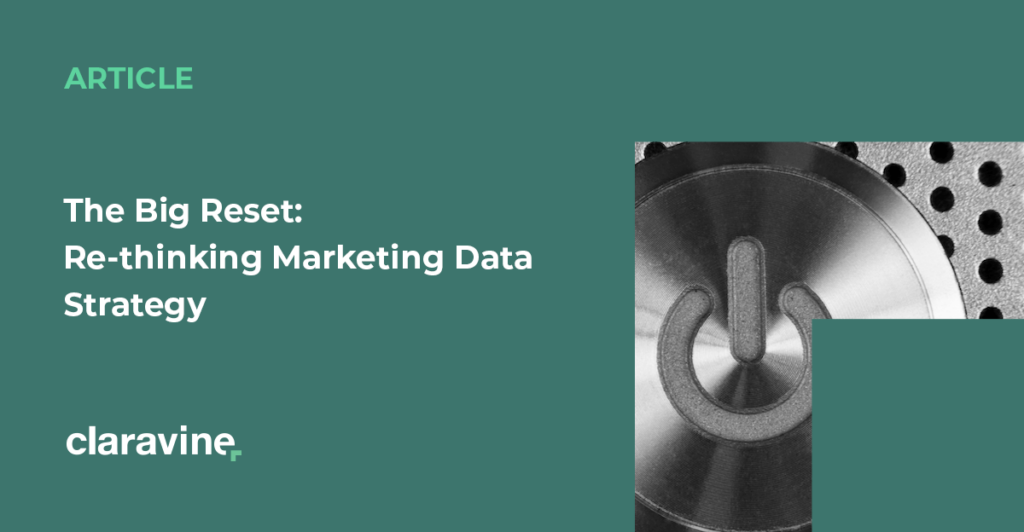The Big Reset: Re-thinking Marketing Data Strategy
Three steps for future-proofing your marketing, once and for all

The easy way is rarely the right way, in life, or in business.
When enterprises respond to changes in technology, consumer behavior, or the marketing landscape with slapdash approaches, they save time in the short-term, but compromise long-term success. With the average tenure of a CMO hitting record lows, it is understandable many gravitate to the path of least disruption–the path to quick wins. But between pro-privacy legislation, Google’s decision to phase out third-party cookies, and Apple calling it quits on device-level identification (IDFA), marketers have no choice but to embrace sweeping change.
Before diving head first, though, business leaders need to hit “pause.” It is time for a marketing reset.
When first-party data is everything
To succeed in the cookieless future, companies need privacy-compliant strategies for acquiring new customers, creating personalized experiences, and measuring campaign performance. These new strategies hinge on first-party data, collected across a brand’s website, apps, loyalty programs, and other digital experiences.
But do organizations have the technology and processes they need to collect, analyze and activate this data? For most enterprises, the answer is no. Plowing ahead business as usual is not an option. So seize this moment as an opportunity to define your marketing data strategy, and invest in what is needed to achieve it. Here are three critical steps to consider.
1. Create data standards
Ask any optimistic marketer to tell you about the future of their field and they will talk about personalization, contextual targeting, unified customer experiences, and automated marketing workflows that save teams time and money. But they are forgetting to mention this future’s foundation: data standards.
Data standardization is the process of defining a common data language for your organization. It requires you to map brands and regions and identify stakeholders who own channels and information domains. Then, you must work together to create a data taxonomy, a systematic approach to collecting and grouping data that ensures every team and region is aligned on how data is defined and managed, ensuring consistency across each campaign and use case.
As part of this process, companies should define their measurement approach and identify the data dimensions they will need across teams and systems to measure and optimize marketing efforts. It is important to do this proactively, as you may not be able to add new data dimensions after your data taxonomy has been rolled out. If you do add dimensions after the fact, it will be time-consuming and slow down business decisions and automation.
For global organizations, data standardization is particularly important. These enterprises have numerous departments and external partners running marketing campaigns on their behalf. Without a common data language and measurement approach, teams are probably using conflicting taxonomies based on different data sources and metadata tags depending on the region and use case. This leads to errors in marketing execution and less accurate and robust marketing insights. It also guarantees the data analytics team spends their time on mind-numbing data integration and data clean-up projects rather than on gleaning meaningful data-backed insights.
Creating a taxonomy allows data to flow smoothly through your organization and reduces time spent managing data. It also facilitates more accurate, detailed insights to maximize the value of owned channels and improve ad and marketing performance in a world without personal identifiers. To put it succinctly, standardizing data increases marketing ROI.
A recent piece in AdExchanger explores how Mondelez took control of its data to increase global ROI by 70%. Before partnering with the data and digital media consultancy Mighty Hive in 2017, Mondelez owned its data, but it didn’t control it. Anytime it wanted access, it had to request it from Google, who looped in Mondelez’s agency to ask for permission. The process was convoluted and frustrating. Mighty Hive helped the company create a data taxonomy. It was challenging, in part because different markets had different regulatory challenges. But now the structure is part of the workflow it uses with every agency around the world. This structure is the foundation for running effective marketing initiatives that aren’t dependent on IDs.
2. Invest in data-sensitive technologies
If you are serious about future-proofing your marketing, you know excel sheets aren’t going to cut it. You need technology solutions to improve, simplify, and protect data processes. According to recent research from an independent market research firm commissioned by Claravine, 83% of advertisers believe they will be more reliant on first-party data moving forward, but only 38% are sure they have the right technology to categorize their data with metadata. As you consider your technology needs moving forward, it may help to think of end-to-end data management in three steps: organizing inputs, handling sensitive data, and organizing outputs.
→ Organizing inputs
Look for a cloud-based data platform to help you define and organize data standards. The platform should integrate with the tools in your tech stack to ensure seamless data sharing. Claravine enables brands to build standards with ease by creating fields, lists and values and defining data relationships in an user-friendly interface. It also connects with major platforms and systems, including Google Analytics, Adobe Analytics, SalesForce, Amazon S3, and Microsoft Azure to facilitate data sharing.
→ Handling sensitive data
Choose a data sharing enabler that meets your firm’s security and privacy requirements so you can roll out your first-party data strategy effectively.
→ Organizing outputs
Look for a platform that can aggregate data pipelines from all your marketing solutions into a single repository. Data inputs should be organized and accessible by your finance, business intelligence, and data analytics team. Choose a solution that allows you to track and analyze data in real-time so you can make quick decisions.
As you build your tech stack, be sure you have defined a measurement framework that can operate independent of personal identifiers. Consider how you will use the framework at each step and across every marketing effort to assess performance and inform future spending.
3. Go all-in on change management
Incredible business innovation has come out of Covid-19: from retailers enacting new e-commerce programs, to global workforces shifting to remote work overnight. Quick pivots are commendable, but the long-term success of these initiatives depends on processes and training.
Like many of the transformational decisions made during Covid-19, leaning into first-party data is at once
reactive and a long-time coming. Big tech players may have forced brands’ hands, but many believe privacy-friendly advertising will be a good thing long-term: 37% of advertisers believe the end of device-level IDs will have a positive impact on their business, opposed to 30% who say the impact will be negative, according to Claravine’s new study.
While companies have to move quickly, they don’t need to be hasty. It is worth taking a thoughtful, methodological approach to creating and launching your unified data strategy; otherwise, the approach won’t be sustainable. Be sure to be mindful of how big a change this is for your organization. Define new processes, plan ongoing training, and seek partners to help improve process and platform adoption. Communicate to your teams that these shifts are designed to improve the employee experience and ensure long-term marketing success. Technology is not a threat to one’s job, but rather, a tool for removing roadblocks and automating processes so marketers can improve performance.
Business leaders would also be wise to position marketing changes as part of a larger cultural shift: an embracing of experimentation and innovation. Historically, marketing has been based on observation, i.e. reviewing performance data when the campaign ends and attempting to make better decisions next time. Today’s category leaders make lightning-fast, data-backed decisions. With personal identifiers on their way out, the last click/last touch attribution model is no longer an optimization option. Companies have no choice but to leverage data inputs to build out marketing mix models and measurement strategies, and to continually test and refine.
While privacy changes create marketing and measurement challenges, they create opportunities, too. The brands that seize them will indubitably be the ones that get data strategy right. So take the time to create your plan, and invest in the steps needed to ensure marketing success in a non-ID future.
About the Author
 Chris Comstock is Claravine’s Chief Product Officer and has more than 15 years in the digital marketing and data management fields – working as a consultant, brand and product leader for a variety of top companies. He now heads Claravine’s product vision.
Chris Comstock is Claravine’s Chief Product Officer and has more than 15 years in the digital marketing and data management fields – working as a consultant, brand and product leader for a variety of top companies. He now heads Claravine’s product vision.




